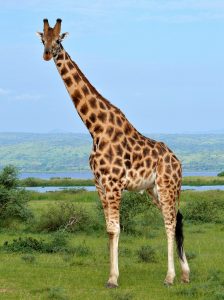Giraffe
 Scientific Name : Giraffa camelopardalis
Scientific Name : Giraffa camelopardalis- IUCN Status : Vulnerable
- The giraffe is a large African hoofed mammal.
- It is the tallest living terrestrial animal and the largest ruminant on Earth.
- The giraffe’s chief distinguishing characteristics are its extremely long neck and legs, its horn-like ossicones, and its spotted coat patterns.
- Giraffes live in herds of related females and their offspring, or bachelor herds of unrelated adult males, but are gregarious and may gather in large aggregations.
- The giraffe has intrigued various ancient and modern cultures for its peculiar appearance, and has often been featured in paintings, books, and cartoons.
- The giraffe is one of only two living genera of the family Giraffidae in the order Artiodactyla, the other being the okapi.
- Fully grown giraffes stand 4.3–5.7 m (14.1–18.7 ft) tall, with males taller than females.
- The coat has dark blotches or patches, which can be orange, chestnut, brown, or nearly black, surrounded by light hair, usually white or cream coloured.
- Both sexes have prominent horn-like structures called ossicones, which can reach 13.5 cm (5.3 in)
- They are formed from ossified cartilage, covered in skin and fused to the skull at the parietal bones.
- The giraffe has an extremely elongated neck, which can be up to 2.4 m (7.9 ft) in length.
- The giraffe’s neck vertebrae have ball and socket joints.
- Giraffes usually inhabit savannahs and open woodlands.
- Giraffes are usually found in groups that vary in size and composition according to ecological, anthropogenic, temporal, and social factors.
- Reproduction in giraffes is broadly polygamous: a few older males mate with the fertile females.
- Giraffes have high adult survival probability, and an unusually long lifespan compared to other ruminants, up to 38 years.
- The primary causes for giraffe population declines are habitat loss and direct killing for bushmeat market.
- Translocations are sometimes used to augment or re-establish diminished or extirpated populations, but these activities are risky and difficult to undertake using the best practices of extensive pre- and post-translocation studies and ensuring a viable founding population.
